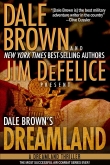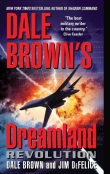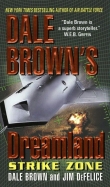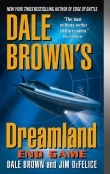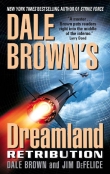
Текст книги "Satan's Tail"
Автор книги: Dale Brown
Жанр:
Боевики
сообщить о нарушении
Текущая страница: 3 (всего у книги 22 страниц)
Woods ought to be twice as busy, Storm thought, but he seemed to relish harassing him.
“Arrange a secure video conference with the admiral for tomorrow some time, at his convenience,” Storm told his communications specialist. He checked some routine matters, then made his way back to Tac. In the meantime, the rigid-hull inflatable boat they had sent to look for survivors from the missile gunboat had returned empty-handed. The gunboat had sunk without a trace. The Shark Boats had reported no further contacts.
“We’ll let the Abner Read recover her boats and spend the night here, ride out the storm,” he told Eyes. “Then we’ll go south as planned. Let’s see if these bastards have the balls to take another shot at us.”
“I’d like to see them try,” blurted one of the men nearby.
“Did you have a comment, mister?” said Storm, looking over.
“No, sir,” said the man, eyes now pasted on the display screen in front of him.
Storm smiled and winked at Eyes. He had the best damn ships and the best damn crews in the whole Navy.
Dreamland
3 November 1997
1331
THE SESSION IN THE POOL HAD DONE ENOUGH OF A NUMBER
on his ego that Mack Smith decided he would eat lunch by himself, resorting to one of Dreamland’s vending ma-
40
DALE BROWN’S DREAMLAND
chines. This was a challenge in itself—it was impossible to reach the coin slot without dramatic contortions. Fortunately, one of the civilian workers happened by as Mack was just about to give up; she took his change and even punched the buttons for him, and her perfume softened a bit of the sting.
Mack had been offered the option of using a motorized wheelchair but had declined, largely because Zen didn’t use one. The advantages were obvious now as he struggled to build momentum up the ramp to the office he’d been assigned. Working a wheelchair efficiently required a certain rhythm as well as upper-body strength, and he hadn’t acquired either yet.
He hoped he never did. He wanted more than anything to get the hell out of this damn thing.
Ray Rubeo was waiting for him inside the office. The scientist stood staring at an empty computer screen on the worktable at the side of the room, a deep frown on his face.
Mack couldn’t recall a time when the scientist hadn’t worn the frown; Dreamland’s senior scientist seemed to think scowling was part of his job description.
“You were looking to talk to me, Major?”
“Pull up a chair, Doc. I’m already sitting.”
“I’m fine.”
One thing in Rubeo’s favor, thought Mack as he pushed around to the large table that was supposed to serve as his work area: He didn’t give him a look of sympathy.
The table was about two inches too high to be comfortable to work at. Mack leaned forward and unwrapped his sandwich, which was some sort of processed ham and mayo on whole wheat.
“So?” asked Rubeo.
“So what, Doc?”
“You wanted to talk to me. In person. I am here.”
“Yeah, I do. I’m taking over Piranha.”
“Taking over Piranha? How? That’s a Navy project.”
SATAN’S TAIL
41
“I don’t mean taking it over, exactly. I’m, you know, liaisoning. So I’m getting up to speed.”
Rubeo’s frown deepened. Mack ignored it.
“I was looking at the reports and it seems to me there’s one constant. You need more people.”
“I would say that is a constant, yes.”
“So the first thing we have to do is get you more people.”
“And?”
This was not exactly the response Mack had anticipated.
While he knew that the scientist didn’t have it in him to jump up and down in thanks, he had hoped that by acknowledging that the staff was overworked he might show from the start that he was on the team’s side. This, of course, would pay dividends down the line, when he had to pressure them for more results.
“And I’m going to try to get you more people.”
“Thank you, Major,” said Rubeo, in a tone that suggested thanks was the last thing he had on his mind. The scientist started to walk from the room.
“Hey, Doc, where are you going?”
“Was there something else?”
“I thought maybe you could run down where we were with some of the related programs. It seems to me that the real potential here—”
“You haven’t been given the reports?”
“What’re these tactical UAV things, the Littoral Combat Intrinsic Air Multiplier Systems? Now those are pretty interesting.”
“Piffle,” said Rubeo.
“Piffle?”
“A worthless Navy project. We’re not involved. They want to run the tests here—assuming they ever get the project out of their CAD programs.” Rubeo wrinkled his nose, as if he’d caught a whiff of sulfur. “You might try informing them that there’s very little water in the middle of the Nevada desert.”
“I thought they were just adaptations of the unmanned he-
42
DALE BROWN’S DREAMLAND
licopter system,” said Mack. “I thought the project only got bagged because of the budget.”
“UHS was a Dreamland project, that is correct,” said the scientist, referring to the program by its initials. “This is different. If the Navy would deign to use a design that was originally done for the Army—as UHS was—then there would be no problem.”
“They won’t use it?”
Rubeo rolled his eyes.
“These Navy things look like the Werewolves,” said Mack.
“Hardly. The Werewolf works.”
Rubeo started away. Mack wheeled forward and grabbed his shirtsleeve.
“What about the Integrated Warfare Computing System?”
asked Mack. “It’s already installed in their littoral combat ships. We have some interfaces for it.”
The scientist snorted.
“Problems?” asked Mack.
“The Navy’s computer code reminds me of the programs that were part of the TRS-80,” said Rubeo. “Without the benefit of being compact.”
“I assume that’s some sort of put-down, right?”
“The TRS-80 was a Radio Shack computer dating from the 1970s. Yes, Major, it was a put-down. We have interfaces, though to be honest, why anyone would want to use them is beyond me. Their systems crash every eighteen to twenty-four hours.”
“So why don’t they just bag the crappy computer and use one of ours? Or even something off-the-shelf?”
“You haven’t dealt with the Navy much, have you?”
“I’ll just straighten them out, then.”
A faint glimmer of a smile came to Rubeo’s lips. “I hope you do, Major. Can I go now?”
“Sure,” said Mack. “We should have lunch sometime. I really want to get to know you better.”
“Yes,” said Rubeo, leaving.
SATAN’S TAIL
43
McCarran International Airport,
Las Vegas
1630
CAPTAIN DANNY FREAH WALKED PAST THE ROW OF VIDEO SLOT
machines and turned left into the large baggage claim area.
The flight from New York had landed a few minutes ago, and passengers were just starting to filter in. As Danny walked toward the carousel, a short man in a gray suit approached him from the side.
“You’re Captain Freah, I’ll bet,” said the man.
“Danny Freah, yes,” said Freah. “Lee?”
“That’s me,” said the man, Lee Rosenstein, pumping Danny’s hand. “I thought you’d be in uniform.”
“I’m off-duty,” Danny told him.
“Well, good. You deserve some time off after all you’ve been through,” said Rosenstein. “Let me just grab my suiter.
I see it coming around the bend.”
Rosenstein darted toward an opening in the crowd and grabbed a black suitcase with a multicolored twist of yarn around the handle.
“Clever,” said Danny, pointing at the identifier as they walked toward the exit.
“Until it falls off,” said Rosenstein. “Usually I get to carry it on, but the gate person couldn’t be bribed.”
He smiled, which Danny figured meant he was kidding about the bribe. Without breaking stride, Rosenstein reached to the outer pocket of the suitcase, zipped it open, and retrieved a Mets cap, plopping it on his head. It clashed a bit with the black suit.
“Been a while since I was in Vegas,” added Rosenstein as they reached the hallway. “Not since March or April.”
“I took a taxi. They’re this way,” said Danny. Rosenstein had already started to the right, where a line snaked around a set of ribbons on the sidewalk.
“Man, it’s beautiful weather. Was raining and about thirty-six when I left New York this afternoon.”
44
DALE BROWN’S DREAMLAND
“It’s a little warm for this time of year,” said Danny.
“Let’s go right to Venezia,” suggested Rosenstein. “I’ll check in, then we’ll catch some dinner.”
“Sounds good.”
“I was thinking of Delaman’s to eat. Supposed to be the best restaurant between San Francisco and New York,” said Rosenstein. “I don’t know if that’s true, but the last time I was there it was pretty good. Hey, don’t worry about paying, Captain—this is on my dime.”
“I wasn’t worried,” said Danny. He wouldn’t have known Delaman’s from a diner, but now felt embarrassed at the other man’s suggestion that he would pay. “We’ll go fifty-fifty.”
“First thing you have to learn as a candidate for Congress,” said Rosenstein, “is when to let other people pay for your dinner and when not. This is a time you let other people pay. Enjoy it while it lasts.”
“I don’t know that I’m running for Congress,” said Danny.
“Everybody says that.” Rosenstein smiled. “All the more reason to let me pay.”
Dreamland
1713
ZEN HUNCHED OVER THE CONTROL PANEL, WATCHING THE
computer simulation of the small aircraft’s maneuvers as it ran through a mock bombing run. Flown entirely by the computer, the aircraft managed to duck two antiair laser shots as well as an old-fashioned but still deadly flak barrage as it approached the enemy radar station. It then took a very hard cut right—the angle looked to be nearly forty-five degrees—as it tossed the five hundred pound bomb. The bomb, loosened from the underside of the robot aircraft just at the start of the maneuver, skipped through the air and landed about two meters from its target, the radar van that had been controlling the antiaircraft installation. As the simulation continued, the robot aircraft spun back down toward SATAN’S TAIL
45
the ground, recording the damage its bomb had done.
“The concept definitely works,” said Zen, pushing back from the panel. “In the computer, at least.”
“If it works on the computer, it’ll work in real life,” said Jennifer Gleason.
“I’m not debating that,” said Zen. “I just don’t see how it’s worth it moneywise to turn the U/MFs into bombers. A guidance kit on a dumb bomb is a heck of a lot cheaper. And having a real airplane gives you a heck of a lot more flexibility.”
“I don’t do philosophy,” said Jennifer. “Just computers.”
Zen was in charge of the Flighthawk U/MF-3 project, a responsibility that included not only the present generation of high-speed robot interceptors but also the next generation U/MF-4, which had just flown the simulation. The U/MF-4
was a small, slightly faster aircraft that incorporated everything they’d learned from using the Flighthawk in combat over the past two years. It could remain airborne at least twice as long without refueling, and would be able to operate approximately fifty miles from its mother plane. Its autonomous mode—the developers’ fancy word for flying on its own—was much improved, thanks largely to the refined onboard tactics library developed from the battles Zen had flown with the U/MF-3s. It could also carry a heavier payload, a capacity intended not for bombs but rather a lightweight though powerful chemical laser, which so far had not made it past the conceptual stage.
All in all, the U/MF-4 was a better aircraft than the U/MF-3. But was it better enough to justify the billions of dollars it would take to field a fleet of them?
If it could be used as an attack aircraft as well as an interceptor, maybe—at least that was the thinking at the Pentagon, which had urged the bomb trial.
Urged as in ordered, with a bit of politeness and necessary decorum thrown in. Zen hated Washington politics, but it was a necessary part of life here.
And not just his. Of the three men and two women currently assigned to the sketch phase of the project, at least two 46
DALE BROWN’S DREAMLAND
would be let go if the U/MF-4 project were put completely on hold. They were all highly skilled workers, engineers who at least in theory ought to have no problem finding another job.
But theory and reality didn’t always match. And the stakes would be a hundred times greater at the next stage.
“I can have the simulation transferred to video for you by tomorrow morning,” said Jennifer.
“Thanks.” With everything squared away, Zen went up the ramp to the elevators and then out through the large Megafortress hangar that had been cut into the Nevada desert like an oversized curbstone. The warm air—it was a balmy eighty degrees—felt good after the filtered and AC’d bunker air he’d been breathing the last few hours.
“Hey, Major, how’s it going?” asked Captain Michael Latrec as Zen rolled toward the Taj. Latrec was a flight surgeon—an Air Force doctor whose specialty was dealing with flight crews and the sometimes peculiar effects of air travel. He probably spent as much time dealing with the common cold as anything else, but then again, a runny nose at Mach 3 and 65,000 feet could hardly be called common.
“You believe this weather?”
“Love it,” said Zen.
“It’ll snow tomorrow, watch.”
“Probably.”
“How’s Mack?”
“I busted his chops pretty bad,” said Zen.
“You did? You busted on him?”
“Nah. I just pushed him, like I said I would.”
“You don’t have to ride him,” said Latrec. “More like en -
courage him. Get him to work out, keep at it, that kind of thing.”
“That’s what I’m doing. You sure it’s all in his head?”
“No. I didn’t say it was all in his head. He definitely sustained injuries. It’s just—he may need encouragement to keep going. You were encouraged, and I thought you could give him the same motivation. Been there, done that, that sort of thing.”
SATAN’S TAIL
47
“I’m working on it, Doc.”
“Mack probably appreciates it.”
“That’s not going to happen,” said Zen. “Unless he gets a brain transplant.”
“I think you’ll be surprised,” said Latrec. “Going through something like this …”
Latrec’s voice trailed off, obviously because he realized he was talking to an expert on the effects of “something like this.”
“Don’t sweat it, Doc. And by the way, you owe me a case of Anchor Steam from the World Series. I haven’t forgotten.”
“Oh yeah. Stinking Marlins.” Latrec was from Cleveland, and, after the Yankees, hated the Florida Marlins with a passion. Zen didn’t particularly care, but he knew a good bet when he saw one—the Marlins were underdogs and he was able to leverage a six-pack against a case.
“I’ve been thinking about changing the beer,” said Zen.
“I’ve been drinking these British beers since Brunei. Samuel Smith. Maybe the Oatmeal Stout.”
“Jeez, where am I going to find British beer around here?”
“Plenty of places in Vegas,” said Zen. “And if not, schedule a house call to an air base in London.”
DOG WAITED IMPATIENTLY FOR THE LAST TECHIE TO FINISH ADjusting the in-flight diagnostic monitor—a fancy name for a black box flight recorder—on the right side of his aircraft so he could start the engine on the XF-16Z, the tester he was scheduled to have gotten off the ground forty-five minutes ago.
Last minute technical glitches and engineering fussiness were part of a test pilot’s routine, and Dog was only too happy to put off the pile of pressing bureaucratic details awaiting him over at his office. Technically, taking a turn as a pilot in the heavy test schedule wasn’t part of Dog’s job at Dreamland, and it had been pointed out several times that spending too much time in the cockpit might keep him from the admittedly more important job of running the base and 48
DALE BROWN’S DREAMLAND
its Whiplash component. But from Dog’s point of view, what was the sense of being a pilot if you didn’t fly? Why had the government spent something approaching a million dollars training him and keeping his skills sharp if not to strap Combat Edge flight gear onto his body on a regular basis? And besides, putting his posterior against an ACES II ejection seat every few days or so made the fact that it spent so much time against a cushioned leather seat almost bearable.
Almost.
But the delay was threatening his plans to have dinner with Jennifer. The two hadn’t had much time to see each other since the end of the so-called “Armageddon” mission.
Their deployment to the kingdom of Brunei and Malaysia had interrupted his campaign to more actively “woo” Jennifer, a campaign that he had undertaken with the planning and precision a top pilot would put into a bombing mission.
Not that bombing was like wooing. Not at all. He had to remind himself not to make that comparison to her, at all costs.
“Wooing.” Was that even a word people used anymore?
Was the word “dating” more appropriate? But dating women seemed like something he had done a million years before.
And besides, dating didn’t really cover what he wanted to do. He wanted her to understand, to feel, that he loved her.
And was “wooing.” Not bombing.
“Just another minute, Colonel,” yelled the engineer, disappearing back over the side of the heavily modified F-16.
The Z, as the XF-16Z was called, had started life as an F-16D, a two-seat version of the versatile fighter-bomber manufactured by General Dynamics. The Dreamland wizards had lengthened the fuselage and completely altered the wing and tail, which looked as if they belonged on a stretched version of the F-22 fighter. The slim body of the Fighting Falcon had been bulked up as well, so that the airplane looked more rectangular than round. This was partly to accommodate the larger engine, which was a Pratt & Whitney power plant originally proposed for the Joint Strike SATAN’S TAIL
49
Fighter; the engine was capable of sustained cruising at Mach 1.2 while consuming a little less fuel than an F-16C
would have at subsonic cruise. That there was much more room for fuel in the Dreamland version increased its operating range, giving it a typical combat radius well in excess of a thousand miles, depending on its mission and load.
The XF-16Z had been authorized shortly before Dog got to Dreamland. It originally had been intended as a test bed for a variety of technologies, including the wing construction (considered but rejected for the Joint Strike Fighter) and electronics suite (which would probably form the basis of the next generation of Wild Weasel upgrades). But it also showed how older airframes might be given new life; the Z
could do for the F-16 what the Megafortress had done for the B-52—remake a venerable, solidly designed twentieth century aircraft into a twenty-first century cutting-edge warplane. The Z was a cheaper-to-operate alternative to the strike version of the F-22; it could also be employed as a very capable Wild Weasel and—assuming the weapons people continued to make the progress they’d shown over the last twelve months—a likely platform for the lightweight attack version of the Razor antiair laser currently under development. The chemical laser was scheduled to be strapped to the belly of the Z for tests by early January.
Today’s test was rather prosaic—Dog was merely helping the techies shake out some bugs in the radar unit that helped the aircraft track other airplanes around it. A pair of UAV
drones—early model Pioneers—would be launched as soon as he was airborne; Dog would fly a few circuits and wait for the radar to pick up the craft and track them.
An easy gig, if the techies would just clear out so he could spool up the engine. The engineer reappeared at the side of the cockpit with a small meter, apologizing for some sort of glitch in the circuitry.
“How long is this going to take?” asked Dog.
“Uh, depends. I get a green here and you can go.”
Dog couldn’t help noticing that the needle on the engi-
50
DALE BROWN’S DREAMLAND
neer’s testing device swung into the red zone and stayed there. The engineer mumbled a curse under his breath, then looked up at the colonel and turned red.
“Sorry.”
“I’ve heard those words before,” said Dog. “Is this going to scrub the mission or what?”
“Um, maybe.” The techie reached down and reseated his tester’s clips. This time when he turned the switch dial, the needle pegged the green post on the meter. “Eureka,” said the engineer. “Good to go, sir.”
But as the technician disappeared down the side and the crew with the power cart got ready to “puff” the XF-16Z’s engine to life, a black SUV with a blue flashing light raced toward the aircraft. A sergeant from the Whiplash ground action team, Lee Liu, got out and trotted toward the aircraft.
“Urgent Eyes-Only communication for you, Colonel,”
shouted Liu.
Dog undid his restraints and climbed over the side. “Di-Tullo, you’re going to have to scratch unless you can find the backup pilot,” he yelled. “Somedays you can never win.”
FORTY MINUTES LATER DOG WATCHED THE TUSSLED HAIR AND
tired face of Jed Barclay pop onto the screen at the front of the Dreamland Command Center.
“Colonel, how are you?” he asked. Jed was the National Security Council assistant for technology, and the Martindale administration’s de facto liaison with Dreamland.
“I’m fine, Jed. You look a little tired.”
Jed smiled. “Stand by for Mr. Freeman.”
The screen blinked. The feed indicated that the transmission was being made from the White House situation room, which had recently been upgraded, partly to accommodate secure communications with Dreamland.
“Colonel Bastian, good evening,” said Philip Freeman, the National Security Advisor. “The President has issued a Whiplash Order. Hopefully, this mission won’t be as intense SATAN’S TAIL
51
as some of your others. I’m afraid I have an appointment upstairs. Before I go, I wanted to mention personally that I appreciate the effort you and your people made in Brunei.
Good work, Colonel.”
“Thank you,” said Dog.
Freeman turned away from the screen.
Jed Barclay stepped back into view. “Roughly three weeks ago, one of Libya’s Russian-made submarines left its port on the Mediterranean,” he said. “Ordinarily, they go out a few miles, dive, circle, and go home. This one didn’t. I have some graphics for you, but the illustrations are pretty, uh, basic.”
A blurry black and white photo of a submarine replaced Jed’s face. Dog listened as the NSC assistant described the submarine, an old but still potent diesel-powered member of the Project 641 class, code named “Foxtrots” in the west.
Roughly three hundred feet long, the Libyan submarine had a snorkel and improved batteries, which allowed it to travel for several days while submerged. Capable of carrying over twenty torpedoes and possibly submarine-launched cruise missiles, the vessel posed a serious enough threat to shipping that NATO had sent additional forces to track it down.
An Italian destroyer succeeded in locating it west of Sicily and trailed it as it traveled toward Gibraltar. But the submarine eventually gave it the slip.
Two days later a British antisubmarine warfare group off the Moroccan coast in the Atlantic recorded sounds of a submarine under distress. It failed to surface, and all contact was lost. The boat had not been positively identified, but was thought to have been a Foxtrot. Given the Libyans’ dismal history with the Russian submarines, it seemed likely that the sub had broken up and sunk. An extensive search operation failed to turn up anything.
That closed the matter—until five days ago, when an American submarine in the Indian Ocean off the African coast reported a series of very distant contacts with a sub-
52
DALE BROWN’S DREAMLAND
marine it had never encountered before. The American sub was trailing a Russian cruiser at the time and couldn’t do much more than listen passively as the other submarine passed a good distance away. The crew had originally identified the craft as a Kilo Project 636, a very potent diesel-powered submarine manufactured and exported by Russia.
Subsequent analysis, however, indicated that was wrong.
The analysts were pegging it as a Foxtrot or perhaps a member of the somewhat more refined and larger Tango class.
“The same sub?” Dog asked Jed.
Jed said it certainly seemed to be. If so, it was a potentially ominous development. A loose association of pirates were currently operating in the Gulf of Aden. They had patrol boats of various sizes and configurations; they were using them to rob and extort money from ships headed from and toward the Red Sea and the Suez Canal. They were also running guns and ammunition to rebel movements in Eritrea, Somalia, Sudan, and Ethiopia.
The pirates had been active for several months, their status with the legitimate governments in the region unclear. The Arab League claimed that both Somalia, Yemen, and Ethiopia were working against the pirates, but none of the other countries would agree to work with the UN or NATO
to combat them. This was no surprise in Somalia—the government wasn’t much more than a fiction. Sudan and Yemen had their own share of conflicts and troubles, but Ethiopia’s reluctance to cooperate was difficult to explain; they were in-land and historically not allied with either country. The only possible explanation had to do with Islamic terror organizations and secret government alliances—a possibility that implied the Libyan submarine might be the first of many.
Things had gotten so bad that two weeks earlier a small contingent of U.S. ships had entered the Gulf of Aden and begun combating them. They were under orders to remain in international waters and attack only with “hard evidence” or if called by a ship under direct attack. Thus far their suc-cesses had been limited.
SATAN’S TAIL
53
“A submarine would take the conflict to a whole different level,” said Jed. “It’s a pretty bad time for us—most of the Pacific Fleet is near Taiwan, and what’s not there is spread out around North Korea and India. Meanwhile, the Atlantic Fleet is trying to deal with Yugoslavia and the Russian buildup in the Baltic.”
“Which is why the pirates are so active,” suggested Dog.
“Probably. This is where they’ve been.”
A map of the Gulf of Aden came on the screen. Roughly 550 miles long, the arm of the Indian Ocean sat below the Arabian peninsula, sandwiched between the peninsula and the Horn of Africa. Somalia lay at the bottom, on the horn shape; Yemen was at the top, on the Arabian peninsula. To the left was the entrance to the Red Sea, which led to the Suez Canal at the far north.
Jed had shaded the areas along the coasts of Somalia and Yemen to show where the pirates had been most active—a swath roughly five hundred miles long.
“The attacks have been mostly in international waters, where the ships try to stay. The pirates then go into the coastal zones where they know they’ll be safe,” said Jed. “If the submarine is going to join them, it’ll come up from this direction here.”
He pointed at the right side of the map, on the horn, where Somalia butted into the Indian Ocean.
“You don’t think it’s heading for the Persian Gulf?”
asked Dog. The Persian Gulf, which bordered Saudi Arabia, Kuwait, Iraq, and Iran, lay farther east, just off Jed’s map. “The Libyans have worked with the Iranians before, and the Iranians are the ones to watch in the Middle East, if you ask me.”
“Um, yes, but they’ve been pretty quiet since Razor’s Edge,” said Jed, referring to the code name for an operation in Iran concluded some months before. Whiplash had destroyed an Iranian laser similar in design to the American antiair weapon known as Razor. “Besides, a NATO squadron is already operating there,” he added. “There’s an American 54
DALE BROWN’S DREAMLAND
destroyer and two French ships guarding the Strait of Hormuz, and an Italian vessel farther north in the Persian Gulf.
If the sub does try to get into the gulf, those ships will find it at Hormuz. The Gulf of Aden is much more problematic. If the submarine is in territorial waters, we can’t touch it, and may even have trouble just tracking it.”
Though Jed didn’t explain, Dog realized that the administration was reluctant to push the territorial waters issue, not so much because it feared foreign reaction, but because of congressional criticism of the Martindale administration for acting unilaterally over the past six or seven months. Even though the administration had twice prevented wars between China and Taiwan and once between China and India, the politicos used the international criticism to bash Martindale.
Senate Majority Leader Barbara Finegold had as much as said so in an interview on CNN a few days before, when she promised to hold hearings on President Martindale’s “hidden foreign agenda.”
“Why would the Libyans get involved with pirates?” Dog asked. “Are they getting a cut of the booty or what?”
“The pirates aren’t just thieves,” Jed explained. “They’re part of a network of Islamic militants. They’re attacking shipping partly for money and partly to help fund an Islamic revolt in North Africa. Sudan, Eritrea, Somalia, maybe even Ethiopia and Yemen—they’re all in play. There are organizations in each country, and they’re each affiliated with Al Qaeda, the people who are operating in Afghanistan.”
“And who funded the takeover in Brunei.”
“Same people. The Brunei movement probably used some of the money the pirates raised. We don’t have any evidence that they’re involved with the Libyans, or this submarine,”
added Jed. “But there have been efforts to get Ethiopia and Yemen as well as Egypt and even Oman to join the conflict.
Ethiopia and Yemen both scrambled planes a few days ago.”
“To attack the pirates?”
“More like to protect them. But they deny that.”
“What happens if we find the sub?” asked Dog.
SATAN’S TAIL
55
“It depends on exactly what you find. If there’s evidence of it working with the pirates, the Secretary of State will take it to the UN. He’s pushing for a resolution that will authorize action against them no matter where they are.”
The Dreamland Command Center was set up like a the-ater, with benches of computer displays arranged in a semi-circle down toward the front screen. The displays could be tied to different systems during an operation, or used to tap into various databases. Dog stooped down to the one near him and tapped in the address for a mapping system, bringing up a detailed view of the Somalian coast. There were literally thousands of places a submarine might go along the coast of Africa.

